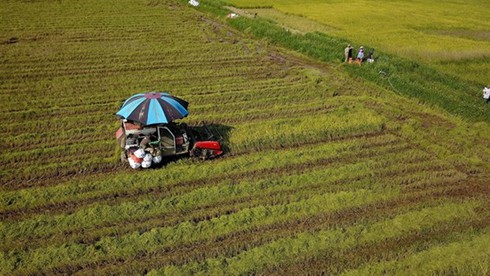Land policies restrain Vietnam’s agricultural development
Fri, 25 Oct 2019 14:08:00 | Print | Email Share:
Scattered, small-sized land lots hamper farmers and stop companies from investing in agriculture, while barriers set by land accumulation policies also marginalise farmers and hinder the development of Vietnam’s agriculture.

Farmers harvest rice in Gia Vien district, the northern province of Ninh Binh.
Land accumulation has been expected to change the face Vietnam’s agriculture
yet showed several shortcomings in need of proper solutions
These warnings were voiced by experts at the Vietnam Autumn Agricultural Forum 2019 – the largest gathering of researchers and policy-makers to discuss the impact of land policies on agriculture hosted by Vietnam Institute for Economic and Policy Research (VEPR).
According to a report issued by VEPR, Vietnam is among the countries with the lowest farming area per capita.
The area of agricultural land per capital in Vietnam is 0.25 ha, below the world and regional averages of 0.52ha and 0.36ha, respectively.
The country’s agriculture depends heavily on some 10 million farming households with more than 76 million small land lots, hindering efforts to apply tech applications, collaborate with enterprises and establish concentrated production areas in the context of intensive global integration and rising climate change.
Land accumulation has been set to tackle these issues yet has fallen short of expectations due to inadequacies of current policies involving agricultural land.
Vu Trong Khai, former director of the Central Agricultural Cooperative Management School II, stressed upon the standardisation of terms and theoretical frameworks to evaluate policies and come up with development plans based on the market-driven economy.
There is an inevitable trend to establish big farms specialising in fruit trees, forest trees or fish breeding to utilise advantages of the economies of scale and technologies,” he said.
First and foremost, Khai stressed that agricultural land must be made available for long-term rental.
Skilled labour force is the second essential factor to accelerate good farming practices and high-tech agriculture.
A strong legal framework is necessary to protect and encourage farmers and enterprises to invest in agriculture.
Tran Cong Thang, Director of the Institute of Policy and Strategy for Agriculture and Rural Development (IPSARD), said fees and taxes applied to the transfer of agricultural land are the same as other real estates. Meanwhile, domestic private enterprises can only hire agricultural land because property rights to agricultural land are not guaranteed like other land types.
There is no official instruction on changing land use purposes from planting to animal farming as well as the Government’s roles in assisting enterprises to hire land.
Thang recommended reinforcing monitoring on the minimum area of an agricultural land lot to avoid scattering fields, reduce taxes and fees related to transfer of agricultural land, encourage enterprises to invest into agricultural support services and develop an electronic land surveillance system to provide digitalised data on land use rights and transfers to ensure the market’s transparency.
In 2018, agriculture contributed 14.7 percent of Vietnam’s GDP with the export value of 40 billion USD.
The country has witnessed an upward trend in a number of enterprises participating in agricultural production. Up to 90 percent of them are small enterprises employing 10 to 50 workers with the average capital of 1-5 billion VND (43,000- 215,000 USD) and the annual income of 3.6 billion VND (154,800 USD).
By: VNA/VOV
---------------------------------------------
Same category News :













